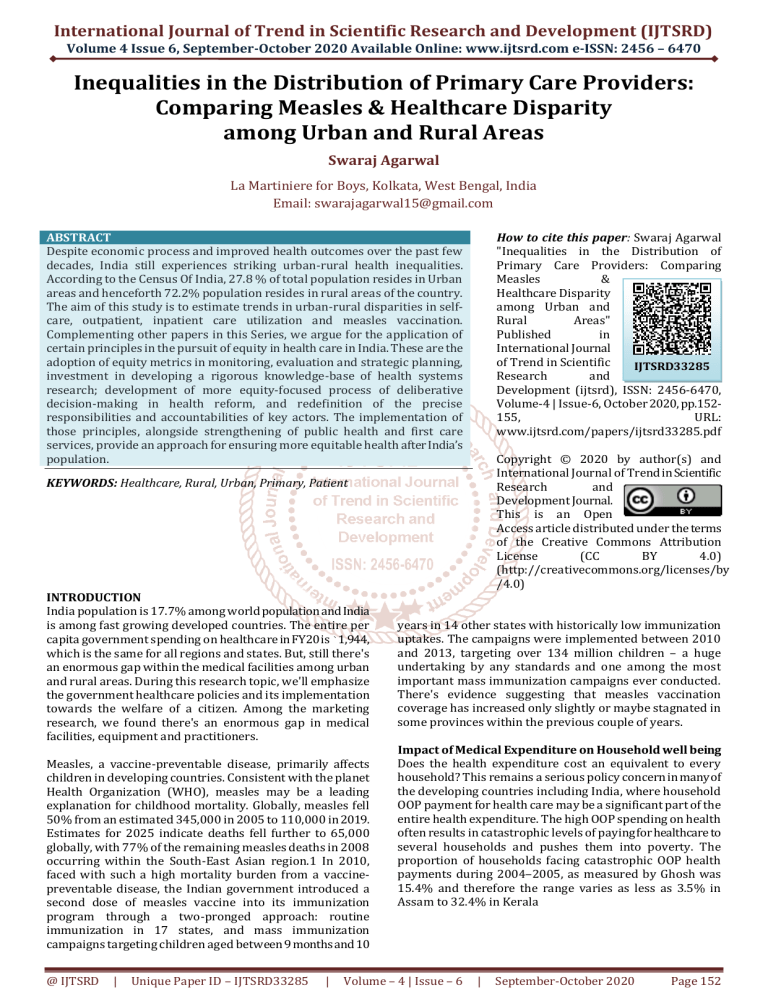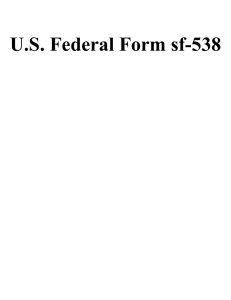
International Journal of Trend in Scientific Research and Development (IJTSRD)
Volume 4 Issue 6, September-October 2020 Available Online: www.ijtsrd.com e-ISSN: 2456 – 6470
Inequalities in the Distribution of Primary Care Providers:
Comparing Measles & Healthcare Disparity
among Urban and Rural Areas
Swaraj Agarwal
La Martiniere for Boys, Kolkata, West Bengal, India
Email: swarajagarwal15@gmail.com
ABSTRACT
Despite economic process and improved health outcomes over the past few
decades, India still experiences striking urban-rural health inequalities.
According to the Census Of India, 27.8 % of total population resides in Urban
areas and henceforth 72.2% population resides in rural areas of the country.
The aim of this study is to estimate trends in urban-rural disparities in selfcare, outpatient, inpatient care utilization and measles vaccination.
Complementing other papers in this Series, we argue for the application of
certain principles in the pursuit of equity in health care in India. These are the
adoption of equity metrics in monitoring, evaluation and strategic planning,
investment in developing a rigorous knowledge-base of health systems
research; development of more equity-focused process of deliberative
decision-making in health reform, and redefinition of the precise
responsibilities and accountabilities of key actors. The implementation of
those principles, alongside strengthening of public health and first care
services, provide an approach for ensuring more equitable health after India’s
population.
How to cite this paper: Swaraj Agarwal
"Inequalities in the Distribution of
Primary Care Providers: Comparing
Measles
&
Healthcare Disparity
among Urban and
Rural
Areas"
Published
in
International Journal
of Trend in Scientific
IJTSRD33285
Research
and
Development (ijtsrd), ISSN: 2456-6470,
Volume-4 | Issue-6, October 2020, pp.152155,
URL:
www.ijtsrd.com/papers/ijtsrd33285.pdf
Copyright © 2020 by author(s) and
International Journal of Trend in Scientific
Research
and
Development Journal.
This is an Open
Access article distributed under the terms
of the Creative Commons Attribution
License
(CC
BY
4.0)
(http://creativecommons.org/licenses/by
/4.0)
KEYWORDS: Healthcare, Rural, Urban, Primary, Patient
INTRODUCTION
India population is 17.7% among world population and India
is among fast growing developed countries. The entire per
capita government spending on healthcare in FY20 is `1,944,
which is the same for all regions and states. But, still there's
an enormous gap within the medical facilities among urban
and rural areas. During this research topic, we'll emphasize
the government healthcare policies and its implementation
towards the welfare of a citizen. Among the marketing
research, we found there's an enormous gap in medical
facilities, equipment and practitioners.
Measles, a vaccine-preventable disease, primarily affects
children in developing countries. Consistent with the planet
Health Organization (WHO), measles may be a leading
explanation for childhood mortality. Globally, measles fell
50% from an estimated 345,000 in 2005 to 110,000 in 2019.
Estimates for 2025 indicate deaths fell further to 65,000
globally, with 77% of the remaining measles deaths in 2008
occurring within the South-East Asian region.1 In 2010,
faced with such a high mortality burden from a vaccinepreventable disease, the Indian government introduced a
second dose of measles vaccine into its immunization
program through a two-pronged approach: routine
immunization in 17 states, and mass immunization
campaigns targeting children aged between 9 months and 10
@ IJTSRD
|
Unique Paper ID – IJTSRD33285
|
years in 14 other states with historically low immunization
uptakes. The campaigns were implemented between 2010
and 2013, targeting over 134 million children – a huge
undertaking by any standards and one among the most
important mass immunization campaigns ever conducted.
There's evidence suggesting that measles vaccination
coverage has increased only slightly or maybe stagnated in
some provinces within the previous couple of years.
Impact of Medical Expenditure on Household well being
Does the health expenditure cost an equivalent to every
household? This remains a serious policy concern in many of
the developing countries including India, where household
OOP payment for health care may be a significant part of the
entire health expenditure. The high OOP spending on health
often results in catastrophic levels of paying for healthcare to
several households and pushes them into poverty. The
proportion of households facing catastrophic OOP health
payments during 2004–2005, as measured by Ghosh was
15.4% and therefore the range varies as less as 3.5% in
Assam to 32.4% in Kerala
Volume – 4 | Issue – 6
|
September-October 2020
Page 152
International Journal of Trend in Scientific Research and Development (IJTSRD) @ www.ijtsrd.com eISSN: 2456-6470
Table1: Health care spending on monthly household
income
Health care spending (%) on
monthly household income
Any
Short
Long
morbidity
term
term
All India
6.02
4.43
1.59
Place of residence
Metro
1.13
0.67
0.46
Other urban
3.57
2.42
1.15
More developed
7.73
5.72
2.01
village
Less developed
6.87
5.18
1.69
village
Income
Lowest quintile
14.53
11.15
3.38
Second quintile
4.53
3.27
1.26
Third quintile
2.44
1.74
0.7
Fourth quintile
1.44
1.02
0.42
Top quintile
0.65
0.37
0.28
Social groups
High caste Hindu
5.13
3.65
1.48
OBC
7.59
5.66
1.93
Dalit
5.32
4.06
1.26
Adivasi
3.88
2.78
1.1
Muslim
4.84
3.88
0.96
Other religion
9.19
4.36
4.83
Current Trends
Government health services in rural India are mainly
provided through a three-tier hierarchy of publicly funded
health facilities, with community health centres (CHCs) – 30bed, 24 × 7 rural hospitals that serve about 120,000 people –
at the highest, primary health centres (PHCs) within the
middle, and health sub-centres (HSCs) at rock bottom. While
HSCs and PHCs provide essential healthcare services, the
CHC provides specialist services and acts as a referral centre
for the PHCs and HSCs in its catchment basin.
It provides specialist services to affect surgical, paediatric,
obstetric, and gynaecological emergencies through a team of
healthcare professionals that has four specialist doctors
(doctors with a postgraduate medical degree in specific
areas), namely surgeon, paediatrician, obstetrician, and
anaesthetist.
Fig1: Breakdown of number of beds among Private
and Public Hospitals
@ IJTSRD
|
Unique Paper ID – IJTSRD33285
|
Since private health facilities that provide specialist services
are mostly found in urban areas, the onus of providing
access to specialist services in rural areas primarily lies with
CHCs. India spends a little extent of its financial plan on
human services. Expanded budgetary designations to
National Rural Health Mission prompted altogether
improved wellbeing results: the vast majority of this
improvement happened in rustic zones, diminishing
wellbeing imbalances. Nonetheless, generally speaking
budgetary assignments to medicinal services stay low,
around 1% of total national output (GDP), limiting ideal
upgrades.
Fig2: Medical Infrastructure (Urban vs Rural)
To understand the issues on the ground in urban and rural
areas of west bengal, we conducted field research in Kolkata
District, a small area in the eastern region of India. Kolkata
or Calcutta, a third tier city, and encompasses a total of 72
towns, 527 towns and villages, and 2 townships. In Kolkata,
we interviewed physicians, health administrators, and
government officials to understand their healthcare needs
and challenges.
The shortage and unequal distribution of a specialist
workforce at the CHC level can have serious implications not
just for maternal and child mortality but also for the
standard of health service delivery at higher levels, like indistrict or regional hospitals. Since the agricultural poor
mostly believe publicly funded facilities for their healthcare
needs, the shortage of specialists at the CHCs often forces
them to either forgo treatment or avail specialist services
from the private sector, which is infamous for its exorbitant
fees. The shortage of CHC specialists may cause higher
disease burden and mortality for the agricultural population,
and it could also trap rural households into a vicious poverty
cycle thanks to the high out-of-pocket expenditures faced
when seeking medical aid.
Fig3: Education of household earner and
Immunization Status
Volume – 4 | Issue – 6
|
September-October 2020
Page 153
International Journal of Trend in Scientific Research and Development (IJTSRD) @ www.ijtsrd.com eISSN: 2456-6470
Out of 577 children, females were 51.9% and males were
48.1%. Urban population was nearly 53% while the rural
population was 47%. Most of the family earners were
illiterate (40% n=230), followed by higher education (35.2%
n=203), Primary (12.5% n=72) and traditional education
like Madarsa (2.42% n=14). Monthly income of families
ranged from Rs.2,000 to Rs. 31,000. Most of the family
earners were private employed (41.7%), followed by
labourers (25.6%) and government servants (32.7%).
public health activists often point out, healthcare is not like
any other consumable where the consumer can hold out for
better prices. When faced with the prospect of a sick or dying
relative, a person will choose expensive tests and
procedures. Patients and families who are given choices
between less and more expensive drugs, tests or procedures
will choose the more expensive one, equating the higher
price with better guarantee even though the more expensive
drug, test or procedure may not be scientifically proven to be
better.
Fig4: CHCs centres distance in Km
The distance had no significant effect on Immunization
status below 13km but it had a clear effect on immunization
above 13 km (Fig 2). Similarly respondents who thought
immunization wasn’t of any benefit had a very low
immunization status (25.5%) than the respondent’s children
who considered it beneficial (71.5%).
The lack of specialists in CHCs also forces the agricultural
poor to hunt specialist services from higher-level, publiclyfunded hospitals (such as district hospitals and medical
colleges) or other CHCs in proximity. The influx of those
patients who should be treated at their local CHC, into the
higher-level facilities that are meant for complex and high
cases or in other CHCs, often results in overcrowding, long
queues, delays in treatment, and untimely deaths. the
shortage or unequal distribution of the health workforce (for
instance, specialists across CHCs) could also cause the
ineffective use of physical infrastructure and equipment,
rendering the invested infrastructure and equipment
useless. Hence, it is vital to form sure that every one CHCs
are equipped and staffed with a team of 4specialists, as
recommended by the Indian Public Health Standards (IPHS).
Fig6: Projected Trends of Vaccinations
Asset necessities for antibodies expanded from `511 crores
($79 million) in 2013 to `3,587 crores ($ 552 million) in
2020 as new immunizations were thought to be presented in
the Program. The necessities will twofold from 2013 to 2020
if pentavalent immunization is turned out in all States and if
IPV and MR antibodies are included. It will increment
fundamentally again in 2020, if PCV is included.
Conclusion
Lack of awareness, low accessibility and misconception
regarding immunizations and associated low literacy and
poor socioeconomic conditions are the main causes of low
immunization against measles. Government Policies related
to medical facilities should be implemented in a more
organized manner. There are worries that India's interests in
the Pradhan Mantri – Jan Arogya Yojna (PMJAY) will advance
auxiliary and tertiary social insurance, to the detriment of
essential human services. The interview achieved proof and
experience that will be useful for India to turn this around:
helping the PMJAY reinforce as opposed to debilitating
essential medicinal services.
References:
[1] Geological Survey of India https://www.gsi.gov.in
[2] Office of the Registrar General & Census Commissioner,
India https://censusindia.gov.in
[3] Indian Medical
india.org/ima/
Fig5: Survey conducted in nearby locality by Top
Medical Institution
This over-reliance on private hospitals allows hospitals to
charge substantially more than government facilities. As
@ IJTSRD
|
Unique Paper ID – IJTSRD33285
|
Association
https://www.ima-
[4] John E. Ataguba, Kenneth O. Ojo, Hyacinth E. Ichoku.
Explaining
socio-economic
inequalities
in
immunization coverage in Nigeria; Health Policy And
Planning (The Journal of health policy and systems
research)
[5] Healthcare Access in Rural Communities; Rural Health
Information Hub
Volume – 4 | Issue – 6
|
September-October 2020
Page 154
International Journal of Trend in Scientific Research and Development (IJTSRD) @ www.ijtsrd.com eISSN: 2456-6470
[6] Joseph L Mathew; Inequity in Childhood Immunization
in India: A Systematic Review; Indian Pediatrics
https://www.indianpediatrics.net/mar2012/m ar203-223.htm
[7] Brandon Downs; Primary Care and How it Affects
Health Care Costs; Business Benefits Gropus
https://www.bbgbroker.com/primary-care-an d-howit-affects-health-care-costs/
[8] Jacqueline LaPointe; How Broader Primary Care Teams
Can
Decrease
Healthcare
Cost
https://revcycleintelligence.com/news/how-b roaderprimary-care-teams-can-decrease-hea lthcare-costs
[9] Shibre G, Zegeye B, Idriss-Wheeler D, Yaya S;
Inequalities in measles immunization coverage in
Ethiopia: a cross-sectional analysis of demographic and
health
surveys
2000-2016.
https://europepmc.org/article/pmc/pmc7341 655
@ IJTSRD
|
Unique Paper ID – IJTSRD33285
|
[10] Hoosen Coovadia and Irwain Friedmen; Reducing
health inequalities in developing countries
https://oxfordmedicine.com/view/10.1093/m
ed/9780199661756.001.0001/med-9780199 661756chapter-9
[11] Selvaraju V; Health Care Expenditure in Rural India
https://www.researchgate.net/publication/23599527
0_Health_Care_Expenditure_in_Rur al_India
About Author:
Swaraj Agarwal is a senior in high school
at La Martiniere for Boys, Kolkata, India. He
is passionate about the intersectionality of
sociology, economics, public health, and
environmental science, and hopes to
pursue these interests in college. He runs
Micro Treasures, a social enterprise aimed at creating
awareness about and supplying microgreens.
Volume – 4 | Issue – 6
|
September-October 2020
Page 155


